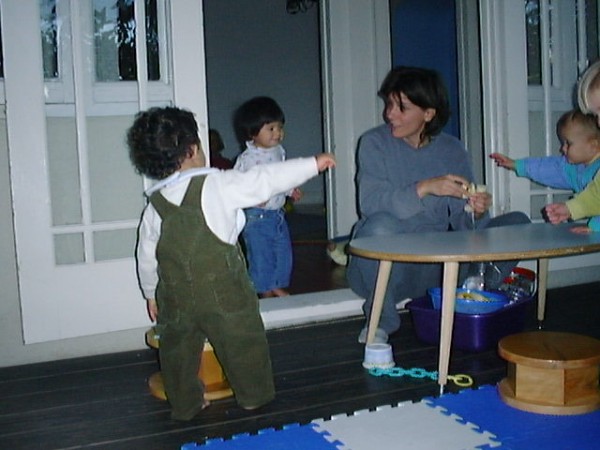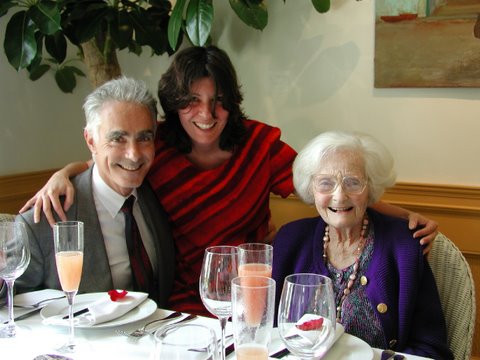Alice Callahan, of Science of Mom, shared my post What To Say Instead Of No, on her facebook page last week, which led her to observe she often says “no” to her daughter, not in an angry way, but in a sad way. This led to a conversation that gave us a fascinating peek into BabyC’s mind and learning process as she struggles with self mastery. Alice also gained insights into how she might best support BabyC in attaining self discipline and co-operation.
Alice: I was watching my use of “no” yesterday and realized that I use it often in a sad way, not an angry way. I use a genuinely gentle but sad tone of voice when BabyC (16 months old), throws her food on the floor: “Oh, no, BabyC, now there is a mess on the floor. You can tell me “all done” when you feel done with lunch.” Lisa, do you think that is any different? I feel like it is useful for me to use “no” as a simple word that instantly conveys that her behavior is inappropriate, followed by the WHY and the alternative.
First: Define And Clarify Your Goals.
Lisa: Alice, I love how thoughtful you are about your parenting! I want to reassure you that it’s not the end of the world if you sometimes use the word “no” when talking with BabyC, but I’d encourage you to try to maintain a neutral tone, as opposed to using a sad tone, because you want to avoid pleading with her to co-operate. You also want to avoid shaming BabyC, making her feel guilty, or acting solely to please you. If you think about discipline as a process of teaching or guiding, and BabyC learning, to make good choices for herself (not dependent on a reward, or pleasing you, or an adult being present to direct her), and you think of your overall goals, it will help you to stay calm and more emotionally neutral.
In the short term, you want BabyC to refrain from throwing her food on the floor, and to learn to tell you when she’s all done so you can simply remove the food instead of having to clean up a big mess. Bigger picture: You want BabyC to learn proper table etiquette, self control, and good communication skills!
Second: Try To Understand Your Child’s Point of View. Ask: Is this behavior developmentally appropriate? What need is my child trying to meet or what is she trying to communicate? What information does my child need in order to better co-operate? What support does she need?
But here’s the thing: BabyC doesn’t yet know or understand that she can/should tell you she’s all done, so she indicates it by throwing her food. Or maybe she understands she can/should tell you she’s done, but for some reason she still throws her food. Maybe she’s doing physics experiments, or it’s just fun, or your reaction is interesting to her, or maybe she just wants to see if your response will always be the same.
It often takes many repetitions for babies and young toddlers to understand what we’re asking of them, and then it takes them time to gain the self control and desire necessary to internalize the requested/accepted behavior, and act on it without being reminded or supported.
Third: Remain Calm. Communicate Directly and Clearly.
By staying calm and emotionally neutral, and simply stating, “Oh, you’re throwing your food, that tells me you’re done, so I’m going to put it away now,” you aren’t giving any emotional charge to the issue. You’re giving BabyC information about how her actions impact you, about the expectations you have, and about what she can do instead of throwing her food.
“BabyC, are you all done? When you throw your food, I think it means you are done. If you throw more peas, I’ll put the food away and lunch will be over. If you still want to eat, please keep the food on the table. If you’re all done, you can hand me your bowl and I’ll help you wash your hands.”
Fourth: Use the Environment to Support Learning and to Minimize Frustration (for Both of you!). Include Your Child in the Process.
BabyC might need to test to see if you mean what you say. I usually give one chance, and then follow through with what I said I’d do. You can make this whole process easier on yourself by using your environment to help encourage the behavior you want to see, and in this way further involve BabyC in her own learning.
By this I mean give BabyC only little bits of food at a time, and before serving more, ask her if she’d like more. Therefore, she has less food to throw and there is less for you to clean up, but even more importantly, you are modeling the behavior and communication you want her to learn, and including her in the process of her own learning.
Fifth: Always Assume the Best. Trust Your Child is Doing Her Best and Will “Get It” in Time.
Trust that BabyC will “get it,” in time. Trust that she is doing the best she can, and she is learning every minute. This is what works so well in the parenting classes I teach, and in group childcare settings. (Did you see Janet Lansbury’s video, Baby Table Manners?) Parents are often amazed at how well their children”behave” and cooperate in these settings. I think it’s because the environment is set up to support children, but also because the communication is so clear and respectful.
It works for parents at home too, but sometimes not quite as smoothly- but this is to be expected, because your baby (ideally) has the closest relationship with you, and so will save her “worst” behavior for you too! It’s an expression of her great trust in you, so it’s a good thing! I used your example of throwing food to describe a process that can be applied to any behavior to help guide a toddler to develop internal control and discipline. (The 7 guidelines are listed throughout this post.) What do you think?
Sixth: Observe. Look For Clues to Determine if You’re on The Right Track.
Alice: Thank you so much for your thoughts on this! The food-dropping thing has been a chronic struggle in our house for several months. It isn’t a huge deal, because I basically do what you suggest: give one warning, and then take the food away if she does it again (as she almost always does). What worries me is that probably 2 out of 3 meals end this way, so I know it is one way that BabyC communicates that she is done with her meal. The other 1/3 of the time, BabyC signs or says “all done” (or both) or hands me her bowl and utensil to indicate that she’s done.
Right before she drops food on the floor, she will often pause and look at me and then shake her head – the same reaction that I give her when she actually drops it. All of this tells me that she knows other ways to communicate that she is done (and I always thank her for telling me in the appropriate ways), but she seems to still be testing my reaction to food dropping. I’m sure it IS interesting to her! But your point about removing the emotion from my response is a great one. That might just make my response less interesting to test. The other thing I know I can do is be more present with her during mealtime. I often finish eating before she does, and I usually pull her high chair around by the sink while I do the dishes. Although I try to stay attentive to her, I’m sure I’m a bit distracted, and I might be missing some of her early signals to me that she’s done eating, so she resorts to food-dropping, which always gets my attention. I’m going to work on this – I’ll let you know how it goes! Thanks again for your insights, Lisa. Your writing and the RIE approach have been so helpful to me.
Seventh: Celebrate Understanding and Signs of Growth!
Me: Oh Alice, This is wonderful insight! You just gave me a missing clue and answered your own question! Your focused attention makes ALL the difference, AND, it is clear BabyC is understanding and working on self control! The pause and head shake tells us this! She understands what the expectation is, she’s thinking about it, and shaking her head is what I call “self talk”. “I’m done and I want to throw my food, but I know this isn’t the best way to tell Mama.” She’s beginning to internalize the expectation, but doesn’t always have the ability (self control) to stop herself (YET).
Remember: Developing Inner Discipline and the Ability to Cooperate and Make Good Choices Takes Time and Lots of Practice.
When I taught RIE Parent/Infant Guidance classes in Silver Lake, there was a barrier of low wooden blocks separating the play area from the entrance area (which was not childproofed). As children became mobile young toddlers, many of them would challenge this boundary by trying to climb over the blocks into the living room. Sometimes, they’d be shaking their heads, or even be saying, “Not go there.” They were struggling to internalize the limit. I’d stay close, and let them push the limit to the very edge. Sometimes, just my quiet presence and focused attention was all the support they needed to refrain from venturing over the edge.
Could they climb up and sit on the blocks? Sure. Fine with me. But as soon as they started to cross to the other side into the entrance area, I’d say, “I don’t want you to climb over the blocks to the other side. If you want to go over there, Mama has to be with you.”
Some children needed to spend an entire class doing this again and again, and some needed to repeat this over many weeks before being able to internalize the boundary- but they all got it.We used the blocks to demonstrate the process of setting boundaries with young toddlers. It was (and still is) my favorite part of working with young toddlers. I love to see how they are actually working on internalizing the concepts. It’s amazing to see how they are all able to accept the boundary too, without having to be reminded again and again, once they go through this process.
It just takes the time it takes, and to us as adults, it can seem to take a very long time! I also understand that it’s harder at home, because I take care of children for eight to ten hours every day, and I go home exhausted some days! In fact, after an hour of teaching a parenting class I can be exhausted, if I’m focusing very intently and working with children around boundaries or conflict!
Alice: Lisa, this is fascinating. Thinking about our food dropping issue this way just makes me appreciate BabyC’s efforts and learning process and helps me to have patience with her.
Has this exchange been helpful to you in thinking about how to understand and work through a discipline dilemma with your own toddler?



